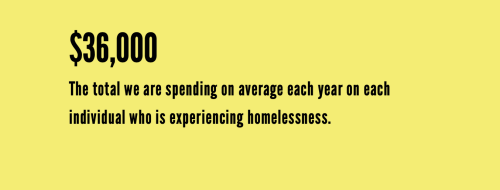Hidden Costs of Homelessness
Homelessness has devastating and direct effects on individuals and families. But communities as a whole often incur massive hidden costs as well, in the form of providing community services and resources, such as healthcare, criminal justice systems, and other emergency services. These are often needed to ameliorate the problem but do little to solve it. Numerous studies have analyzed the costs associated with homelessness and have calculated the cost savings that result when people find housing. The takeaway: It costs less to provide someone with a safe and secure home than it does to let them stay homeless.
Nationally, there were 580,466 people who were homeless in January 2020, according to federal definitions. This includes both people who are sleeping unsheltered, such as outside on the streets, in a tent, or in a vehicle, and people who are sleeping in temporary or emergency shelters. Despite being the federally recognized measurement for the number of people experiencing homelessness, the Point-in-Time count (PIT count) does not fully measure the magnitude of homelessness in this country and systematically undercounts the total population experiencing homelessness. In Charlotte and Mecklenburg County, North Carolina, there were 2,667 people experiencing homelessness, as of July 31st according to the local Continuum of Care(CoC). While providing temporary shelter, including motel stays, to individuals and families who are sleeping outside is vitally important to protect them from the elements, it does not solve their homelessness but merely recharacterizes it from “unsheltered” to “sheltered.” They will still be included in the PIT count and the CoC’s count as homeless. Only secure, stable housing can end someone’s homelessness.
Estimates from the National Alliance to End Homelessness in2017 put the average annual costs of homelessness at nearly $36,000 per person. The following breaks down some of these findings, focusing on Charlotte, North Carolina.
Staying Healthy – Physically & Mentally
When someone is homeless, they have limited ability and resources to obtain ongoing and preventative health care. They increasingly rely on costly emergency health care services like emergency rooms and ambulance rides. Furthermore, homelessness causes and exacerbates stress, mental health issues, and other health conditions that increase the need for healthcare services.
The Moore Place Permanent Supportive Housing Evaluation Study in 2015 included 73 participants who were previously homeless. The study explores the cost savings to the healthcare system when previously homeless people are housed. In the two years after being housed, residents visited the ER 648 fewer times, a reduction of 81% from the previous two years. Housed residents were hospitalized for 292 fewer days than the previous two years. Providing housing to people experiencing homelessness improved health outcomes and saved more than $2.4 million dollars in healthcare related costs for the community.
More Housing. Less Incarceration.
Oftentimes, people experiencing homelessness will have to sleep in public, which conflicts with local ordinances. This segment of the population is also more likely to be the victims of crime, which can increase interactions with police and the criminal justice system.
The Housing First Charlotte-Mecklenburg Research & Evaluation Project 2020 Report which monitored 330 people who previously experienced homelessness, estimates that the average cost of an arrest is $194 and that the average cost to spend one night in jail is $174 .Once residents were housed, the percentage of residents who were arrested fell by 59%. Housing residents reduces interactions with police and the criminal justice system, which increases resources for the community.
Most tenants that participated in the Moore Place study were not previously involved in the criminal justice system, but of the tenants that were arrested or jailed in the preceding two years of the study, there were 90 fewer arrests and 1,050 fewer nights spent in jail once residents were housed. Studies like these often do not measure the additional long-term financial and emotional costs of incarceration, including lasting fines and fees, criminal records, and mental health services needed for this type of trauma.
A Short-Term, but Costly, Solution
Emergency shelters are a costly response that does not end someone’s experience of homelessness. The resources spent to provide an individual or family with a temporary place to sleep could be better used to provide a stable home.
The Housing First Report found that in the year prior to receiving housing, study participants collectively spent 9,372 nights in an emergency shelter. This did not solve their homelessness, but simply recharacterized it. After receiving housing, study participants spent a total of 192 nights in emergency shelters throughout the year, a reduction of 98%. By providing secure and stable housing to those who were previously homeless, the city reduced the average annual shelter cost per person by $1,138.
Community Savings & Impact
The costs of homelessness are staggering, and if dollars were reallocated to more impactful, lasting solutions, we could solve homelessness. For less than $1,000 dollars per year, Lotus Campaign not only can provide a safe and stable home to someone but save on average $35,000 dollars in other community costs. By scaling Lotus Campaign’s model to communities across the country, we can reduce the number of people experiencing homelessness at a fraction of the cost of continuing with the status quo.


